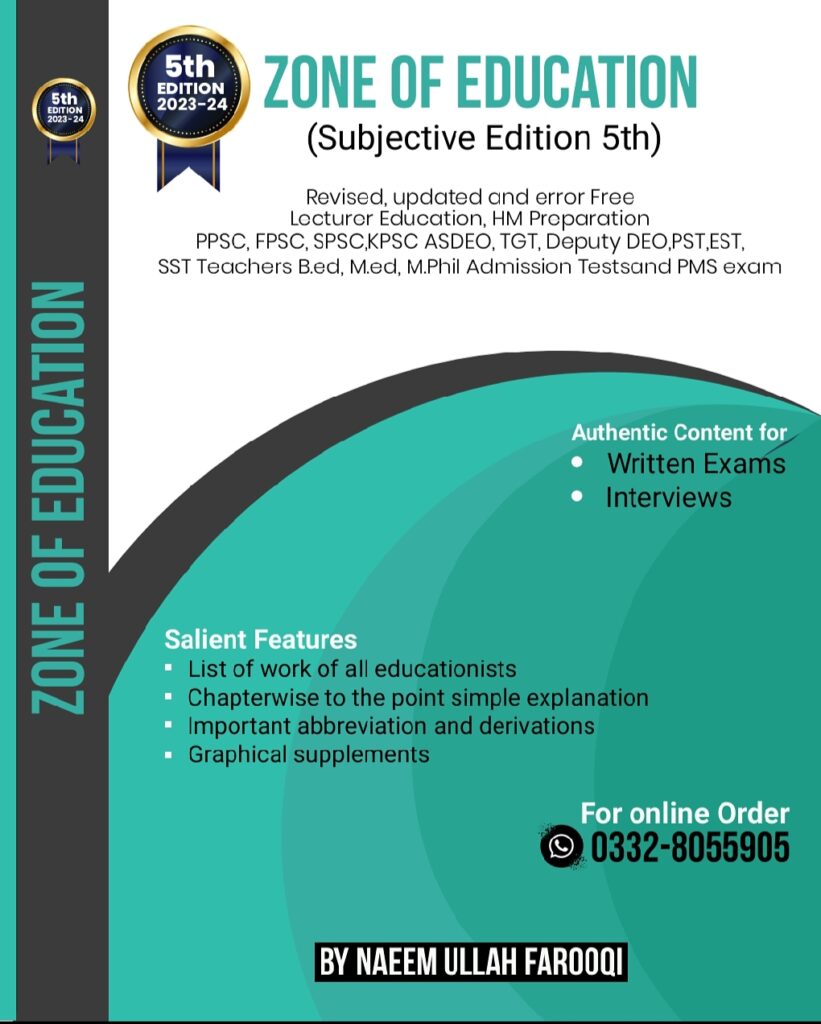GENERAL METHODS OF TEACHING
If some students are not in a mood to study in the class, you will ________.
(a) Force them to study
(b) Tell those students to leave the class and enjoy
(c) Tell them some interesting things related to their interests or your own subject
(d) None of these
Answer: c
Child development is defined as a field of study that________.
(a) Examines change in human abilities.
(b) Seeks to explain behaviour across the life span.
(c) Accounts for the gradual evolution of the child’s cognitive, social, and other capacities.
(d) None of these
Answer: c
The term ‘identical elements’ is closely associated with________.
(a) Group instruction
(b) Transfer of learning
(c) Jealousy between twins
(d) None of these
Answer: b
A person believes that nurture strongly influences the development of his child. He would not agree with the importance of________.
(a) Genetic factors
(b) Exposure to peers
(c) The types of toys at home
(d) None of these
Answer: a
If student is too shy to participate in the class, you will________.
(a) Not ask questions from him
(b) Ask only those questions from him whose answers can be given by him
(c) Ask questions from him only when he is keen to answer them
(d) None of these
Answer: c
A good teacher will bring a hyperactive child on the right path by ________.
(a) Making him sit in front of the class and keep a strict vigil on him
(b) Allocating a seat for him in a corner of the class
(c) Giving him tasks of watering trees, cleaning the blackboard, making toys of clay, etc.
(d) None of these
Answer: c
Knowledge of child psychology is a must for a primary teacher because________.
(a) It helps in making children disciplined
(b) The examination result is improved
(c) It helps the teacher in understanding the behaviour of children
(d) None of these
Answer: c
The movement of behaviour modification, wherein tokens are awarded for correct responses, is a reflection of________.
(a) Herbart’s Five Steps
(b) Lock’s Tabula rasa
(c) Thorndike’s Law of Effect
(d) None of these
Answer: c
Subjects are said to be assigned randomly when________.
(a) They are assigned to experimental and control groups from a sample which is representative of the larger population.
(b) They each have an equal chance of being assigned to either the experimental or control group.
(c) Neither the experimenter nor the subject knows whether the subject is in the experimental or control group.
(d) None of these
Answer: b
Students who do better in high school tend to do better in college. This is an example of a________ correlation
(a) Negative
(b) Zero
(c) Positive
(d) None of these
Answer: c
Fifteen-years-old Ahsan wears the same style shirts that his teacher wears. This is called ________ behaviour.
(a) Compensation
(b) Transference
(c) Identification
(d) None of these
Answer: c
At least one third of the learning that will determine later levels of school achievement has already taken place by age six. This was said by ________.
(a) Benjamin Bloom
(b) Margaret Mead
(c) Martin Mayer
(d) None of these
Answer: a
________ is the he most unreliable predictor of educational achievement.
(a) Inherited biological potential for learning
(b) Ethnic origin of parents
(c) Family background and training
(d) None of these
Answer: b
________ is not an acceptable goal for dealing with behaviour problems in the classroom.
(a) Utilizing appeals to children that have personal implications
(b) Being impersonal and objective
(c) Understanding the offense
(d) None of these
Answer: d
In preparing a class to take a standardized reading test the teacher should________.
(a) Tell the children the test is very important and they should do the best they can
(b) Ditto key questions from a previous test and allow the pupils to answer them
(c) Give the pupils practice in answering questions similar to the type that will appear on the test
(d) None of these
Answer: c
______ is likely to cause the greatest difficulty for a child in the initial stages of reading instruction.
(a) Confusion of left and right directionality
(b) Possessing an IQ of 90
(c) Having older siblings who are successful readers
(d) None of these
Answer: a
An essential of learning called ______ is the one that takes procedure over the other.
(a) Desire to learn
(b) Ability to read
(c) An intact home
(d) None of these
Answer: a
A child from a disorganized home will experience the greatest difficulty with______.
(a) Well structured lessons
(b) Independent study
(c) Programmed instruction
(d) None of these
Answer: b
The normal twelve-year-old child is most likely to______.
(a) Have difficulty with gross motor coordination
(b) Have anxiety feelings about pleasing adults
(c) Be eager for peer approval
(d) None of these
Answer: c
The term ‘identical elements’ is closely associated with______.
(a) Group instruction
(b) Transfer of learning
(c) Jealousy between twins
(d) None of these
Answer: b
The peculiar characteristic of first grade children is that they are______.
(a) Too young to be taught classroom routines
(b) Not yet concerned with group approval
(c) Very concerned with adult approval
(d) None of these
Answer: a
The evaluation of personality is best made through the use of an______.
(a) Inventory test
(b) Projective test
(c) Survey test
(d) None of these
Answer: b
When a pupil’s misbehaviour persists even after the teacher punishes the child for each infraction, the teacher is probably practicing a policy of______.
(a) Retribution
(b) Corporal punishment
(c) Negative reinforcement
(d) None of these
Answer: c
Ayaz and Asad have the same mental age 8.0. We can conclude that______.
(a) They have the same potential for success in school.
(b) They have the same IQ
(c) Their ability to learn may be quite different
(d) None of these
Answer: c
A child whose class is in a windowless room may have to be assigned to another class if he/she suffers from______.
(a) Acrophobia
(b) Agoraphobia
(c) Claustrophobia
(d) None of these
Answer: c
The self-adjective mechanism that teachers often unwittingly encourage is______.
(a) An attention-getting device
(b) Daydreaming
(c) Regression
(d) None of these
Answer: a
When an individual repeats those learning that, in the past, proved to be highly satisfying, such behaviour can best be explained by the law of______.
(a) Effect
(b) Frequency
(c) Readiness
(d) None of these
Answer: a
Children’s attitudes toward persons of different ethnic groups are generally based upon______.
(a) Their parent’s attitudes
(b) The attitudes of their peer
(c) The influence of television
(d) None of these
Answer: a
______ is not a sound mental hygiene practice.
(a) Asking pupils to correct their answers after their tests have been marked
(b) Discussing an individual pupil’s test marks with the class
(c) Asking parents to sign test papers so that that they are aware of their child’s marks.
(d) None of these
Answer: b
All of the following advanced principles of child development are closely allied to the stimulus response learning theory, except ______.
(a) Pavlov
(b) J. B. Watson
(c) Gesell
(d) None of these
Answer: d
All of the following can be signs that a child is gifted, except______.
(a) Early development of a sense of time
(b) Interest in encyclopaedias and dictionaries
(c) Uneasy relationships with peers.
(d) None of these
Answer: c
JOIN ZONE OF EDUCATIONPK!
Discover the most comprehensive and reliable pedagogy resources in Pakistan, curated for competitive exam success. Our content covers all competitive exam MCQs, including PPSC, FPSC, AJKPSC, SPSC, and more. Designed to empower learners with top-notch material and insights, trust us for your preparation journey!


